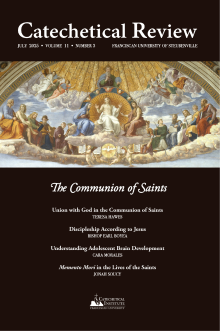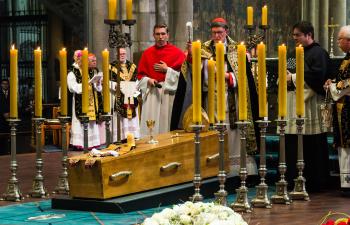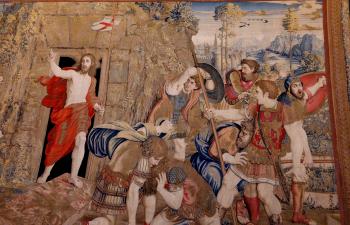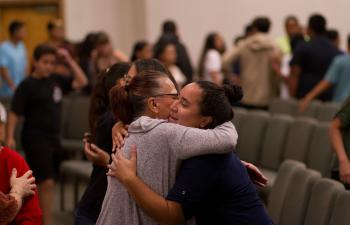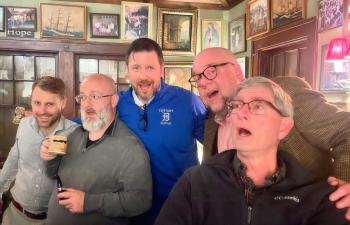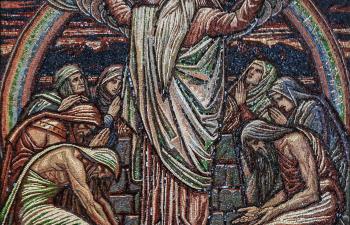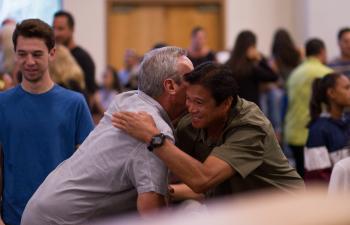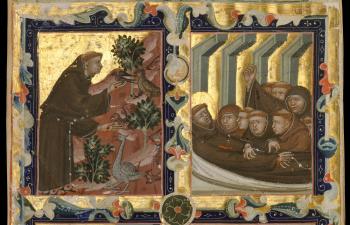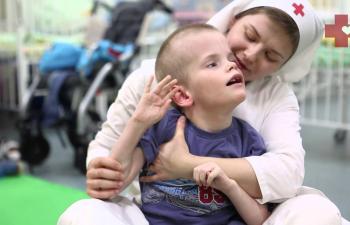 C. S. Lewis’s devil Screwtape advises junior tempter Wormwood, “The parochial organization should always be attacked, because, being a unity of place and not of likings, it brings people . . . together in the kind of unity the Enemy desires.”[1] Christian community makes tangibly present communion with Christ. It is often the first place people begin to encounter him and believe in the possibility of his love, which is manifested through the love of the Church’s members. Even in its veiled, earthly form, the Communion of Saints has the power to radiate Christ to the world. This article will briefly examine the nature of this communion and its power to bear witness to Christ, as well as offer some ideas for fostering a deeper and more intentional living of this communion within our communities.
C. S. Lewis’s devil Screwtape advises junior tempter Wormwood, “The parochial organization should always be attacked, because, being a unity of place and not of likings, it brings people . . . together in the kind of unity the Enemy desires.”[1] Christian community makes tangibly present communion with Christ. It is often the first place people begin to encounter him and believe in the possibility of his love, which is manifested through the love of the Church’s members. Even in its veiled, earthly form, the Communion of Saints has the power to radiate Christ to the world. This article will briefly examine the nature of this communion and its power to bear witness to Christ, as well as offer some ideas for fostering a deeper and more intentional living of this communion within our communities.
The Communion of Saints
The Communion of Saints on earth is quite simple: Its source is Christ; its soul is charity. Christ himself, on the evening before his Passion, prayed, “that they may all be one, as you, Father, are in me and I in you, that they also may be in us, . . . that they may be brought to perfection as one, that the world may know that you sent me, and that you loved them even as you loved me” (Jn 17:21, 23). The members of the Church are “a holy people united with the unity of the Trinity.”[2] The Holy Spirit unites the Church in a single bond of love. Moreover, in the Eucharist, Christ binds each person together so that they are members of this same whole.
Being enriched by Christ’s gift and made one in him opens our horizons. In the midst of its treatment of the Our Father, the Catechism has this stunning line: “Finally, if we pray the Our Father sincerely, we leave individualism behind, because the love that we receive frees us from it” (2792). God’s love frees us. We no longer need to protect ourselves. Transformed by the renewal of our minds (Rom 12:2), grace allows us to see the love God has bestowed on us. It opens our eyes to the fact that my brother or sister in the Lord is in some way part of me.[3] And it moves us to “leave individualism behind,” embracing this communion. We are able to live heroic charity, loving as we have been loved.
“Beloved, let us love one another, because love is of God; everyone who loves is begotten by God and knows God” (1 Jn 4:7). God takes our ordinary nature and, through grace, elevates it to share in his life. This means that simple, everyday gestures of love and care take on extraordinary depth. They are the “stuff” sanctity is made of. I can remember gathering with a group to pray for a friend who was dying. I knew her as my mentor and a gifted catechetical leader, but as others shared how they knew her, I began to realize there was so much more to her life of sanctity than just what she did for the Church in her role as catechist. One friend shared how my mentor had helped her with laundry during her prolonged recovery from surgery. Another spoke of how she had come to understand authentic family life when my mentor had opened her home to her and helped her. These simple, human gestures of love and self-sacrifice provided the deepest and most authentic witness to Christ that my mentor offered in her very full life. This is the kind of love Tertullian said caused the pagans to exclaim, “See how these Christians love one another!”[4] Sometimes it is the humblest gestures that speak the most loudly of Christ’s presence and love.
Living Out Charity in Community
The Directory for Catechesis highlights this living witness of community in relationship as a powerhouse of parish evangelization:
At the heart of the parish’s presentation of evangelization is not a pastoral strategy, much less an elite and exclusive group of the perfect and of experts, but a community of missionary disciples, people with a living experience of the risen Christ who live out new relationships generated by him. A Christian community that, even in the weakness of its members and in the paucity of its resources, lives out this mystical fraternity, itself becomes the first and natural proclamation of the faith.[5]
Our relationship with Christ should overflow into our relations with one another. The Directory envisions parishes as a place where experience of the risen Christ transforms the horizontal relationships of the disciples with one another. In order for this to take place, though, a disciple must also be formed in a spirituality of communion—“the heart’s contemplation of the mystery of the Trinity dwelling in us, and whose light we must also be able to see shining on the face of the brothers and sisters around us,” which sees others as “those who are part of me,” and knows “how to ‘make room’ for our brothers and sisters.”[6]
How is this communion lived? There are, of course, a multitude of ways. I would like to offer only a few points drawn from my own reflections that I hope may prove useful in thinking about parish life.
First of all, as the proverb goes, charity begins at home. St. Francis de Sales calls us to treat those of our own household with special gentleness and care—“a sweetness terribly lacking to some who are as angels abroad and devils at home!”—as an essential element of the devout life.[7] The family as the “domestic church” is the first and proper setting in which charity is lived it. Those responsible for fostering the communion of the parish must first attend to living this communion in their own families. Additionally, any preaching or initiatives that help families to live the love of Christ within their homes will contribute to building up this communion.
Second, charity overflows in concrete concern for our “neighbor.” The Good Samaritan’s first action, moved by compassion, was to take care of the physical needs of the man waylaid by the robbers (see Lk 10:33–34). The humble care of charity is offered in personal prayer, encouragement, and acts of service, responding to the needs of those who immediately touch our lives. As gestures of love, small actions have incredible power: a sympathy card, a frozen meal for a family with a new baby. Good should also be celebrated: “if one part is honored, all the parts share its joy” (1 Cor 12:26). In my religious community, I am always moved when I see how deeply my sisters share my joys or suffering. It is a sign of the love of Christ and a reminder that I am not alone. This carries the most impact when it is a sharing from one member to another for which each takes responsibility, if possible, rather than a result of the engines of a bureaucratic ministry.
Third, charity should be fostered between families within the community. With any parish, there is a possibility for the “business” aspect to overtake the fraternal. In the parish formed in a spirituality of communion, both social and practical events can become places where authentic relationships are formed, opportunities for people to be invited into a deeper fellowship within the parish. Never underestimate the value of Sunday’s coffee and donuts! Some marvelous initiatives have also recently arisen that use small groups made of families to create stable, connected communities that allow an experience of more personal connections within a broader parish setting.
Finally, charity can be set before the whole as a goal. Administration is a charism that should be moved by charity. So also is hospitality. When formation for parish ministries imbues participants with a mindset of fostering communion in charity, it unleashes creativity moved by the Holy Spirit. How can the parish food pantry be moved by a spirituality of communion and authentic Christian charity? Might greeters might be encouraged to look out for new faces and try to connect with those who do not seem to know anyone else? As missionary disciples, members of parish ministries will naturally look for judicious ways to help others feel known and invited deeper into the parish communion once they understand this as their mission.
This is what a love secure in the Father’s love looks like—a love that leaves individualism behind and, at rest in itself, can see that light of the Trinity shining on the face of one’s brother or sister. Founded on and flooded with the charity of Christ, the Church radiates his love to the world in simple gestures. Home and parish are both capable of bearing this witness to Christ. We need only to live this communion and to invite others in.
[1] C. S. Lewis, The Screwtape Letters (Unwin Brothers, 1944), letter 16.
[2] Barbara Morgan and Sr. Athanasius Munroe, OP, Echoing the Mystery: Unlocking the Deposit of Faith in Catechesis (Lumen Ecclesiae, 2021), 256.
[3] Pontifical Council for the Promotion of the New Evangelization, Directory for Catechesis (United States Conference of Catholic Bishops, 2020), no. 88.
[4] Tertullian, Apology chap. 39, sect. 7.
[5] Directory for Catechesis, no. 303, emphasis original.
[6] John Paul II, Novo Millenio Inuente, no. 43.
[7] St. Francis de Sales, Introduction to the Devout Life, Library of Spiritual Works for English Catholics (Rivington, 1876), https://www.ecatholic2000.com/desales/idl.shtml, part 3, chap. 8.
Art Credit: Parable of the Good Samaritan, Fr. Lawrence Lew, OP, Flickr.com
This article originally appeared on pages 90 - 95 of the print edition.
This article is from The Catechetical Review (Online Edition ISSN 2379-6324) and may be copied for catechetical purposes only. It may not be reprinted in another published work without the permission of The Catechetical Review by contacting [email protected]

